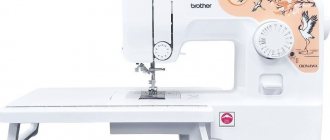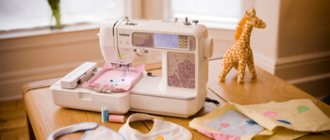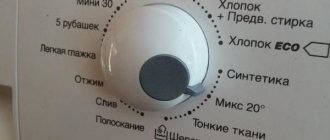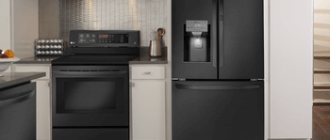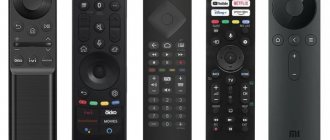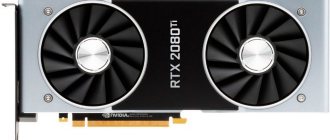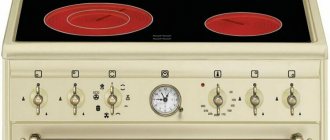On your side, or At your side, is the motto that Brother has been walking around the world for more than a century. And he doesn’t just walk the walk, but regularly introduces new products. And although the number of people personally familiar with this brand is inferior to the multimillion-dollar numbers of admirers of some other brands, large sales confirm that manufacturers are doing everything right. So what products under this name can be found on store shelves today, and what surprising things were released before? What place do printers occupy in the entire product line and what are the features of refilling cartridges?
Today this logo can be seen on many products.
How it all began
1908, Japan, Osaka... An ordinary man with the unusual name Kanekichi Yasui walks along the streets of the metropolis and heads to his tiny home workshop for repairing sewing machines. Here he will revive such a technique that was in demand at that time and will soon understand that he can earn a lot of money from this, at first glance, simple task. This is how the famous company was born.
Already in 1925, his sons, who inherited their father's successful business, founded the Yasui Brothers' Sewing Machine Company brand, better known today as Brother. Few people know that the brothers' first creations were... straw hats. A short time later, the craftsmen released the first sewing machine, and then everything went like clockwork.
Many people associate the name Brother with sewing machines.
Brother - brand history
Brother Industries Ltd is a Japanese multinational corporation with sales offices located throughout the world and production facilities in Japan, Taiwan, Korea, America, Malaysia, Ireland and the United Kingdom. Brother Group employs more than 23,000 people.
The beginning of modern Brother was laid in 1908 in the Japanese city of Osaka by a simple citizen Kanekichi Yasui. In 2008, it took a leading position in the printing equipment market in Europe, the USA and Japan in the segment of monochrome laser printers and MFPs.
The company began in a small family sewing machine repair shop. Gradually, the business grew: in 1925, the Yasui brothers - Jitsuichi and Masayoshi - inherited their father's business and named the company Yasui Brothers' Sewing Machine Company. A couple of years later, the company began producing straw hats, and after another 7 years, the first sewing machine of its own production was released. In 1934, the company was renamed Nippon Sewing Machine Manufacturing Company - the future Brother Industries, Ltd. Within two years, production increased fivefold, and the growth in sales necessitated the creation of a whole new division in 1941 - Brother Sales, Ltd.
The growth of production allowed the Yasui brothers to set themselves a new task - entering the international market. The first delivery of Japanese sewing machines took place in 1947 to Shanghai, and by 1959 exports had surpassed the symbolic mark of one million sewing machines. During these years, the Japanese company gradually mastered a new market niche for electrical appliances: it began producing electric sewing machines, hair dryers, irons, vacuum cleaners, washing machines and other household appliances under the Brother brand, including portable typewriters.
The first Brother portable typewriter appeared in 1961, simultaneously with the start of construction of the company's new headquarters in Nagoya. In the same year, the company adopted the name of its brand - Brother Industries Ltd. In a matter of years, the export of Brother typewriters exceeded their “home” sales, and they themselves became for that time the same reference product as Sony transistor receivers or Canon cameras.
In 1966, the first portable electronic calculator from Brother was released, five years later the company made another splash in the market by creating the world's first high-speed matrix printer M-101, and in 1978 the first typewriter P-14 with letters arranged on round head (“golf ball”). In the next decade, Brother mastered the production of a portable electronic printer powered by batteries.
The “globalization” of Brother’s business was reflected in the adoption in 1999 of the corporate Global Charter (The Brother Group Global Charter), which begins with the words: “Brother’s core mission is to create and quickly deliver superior quality products and services to consumers around the world.” And three years later, the strategic development plan The Global Vision 21 was adopted, which formulated the company’s three main strategic goals until 2012: 1. To become a leading global highly profitable company; 2. Become a first-class manufacturer through the development of outstanding proprietary technologies; 3. Make the advertising slogan “On your side” the basis of the entire corporate culture.
According to research company GfK, by October 2006 the vendor controlled 17% of the European monochrome laser printer market and more than a third of the laser multifunction device (MFP) market.
In 2008, Brother celebrated its centenary. Printing devices (printers and multifunction devices) are the main area on which the company is currently focusing. The company employs 23,809 employees worldwide in 43 sales offices and 19 company-owned factories. In the anniversary year, the company's turnover for 9 months of the 2008 financial year amounted to $3.8 billion, and the share of the company's sales in Russia amounted, according to various estimates, from 5% to 10%.
The Russian representative office of Brother opened in October 2003. Prior to this, there were only isolated, unorganized deliveries of Brother products to Russian customers. In 2003, only 5 people worked in the Moscow office.
On July 19, 2006, Brother LLC was registered in Russia, which took upon itself all the work of importing, customs clearance and prompt delivery of spare parts for Brother service providers.
In Russia and the CIS countries, Brother actively works with sales channels, constantly expanding the list of partners. In July 2009, the company had 9 distributors, about 600 selling dealers, and more than 150 service centers. Like many vendors, Brother is fighting counterfeit products, which is reflected in counterfeit destruction campaigns.
From hats to technology. From Japan to Russia
Knitting, sewing, printing machines, dot matrix printers, vacuum cleaners, hair dryers, irons and other household appliances - the scale grew, the range increased, and the geographical scope expanded. The company became transnational and took root in Taiwan, Korea, Ireland, the USA and more. Brother's Japanese branches are in dozens of countries and have provided employment for more than twenty thousand people.
With the advent of laser monochrome devices and MFPs on the market, popularity has grown exponentially, including in Russia. In 2003, official representative offices appeared on the territory of our state. And with them, you have the opportunity to acquire certified products “on the spot,” without having to go headlong to find a Brother product where it is produced, and use a number of other related common services.
Brother brand is the leader in the world of sewing machines
Brother was founded in 1908, so you can trust a company with more than 100 years of history.
The Japanese brand has become a leader in the market thanks to the introduction of innovations and the pursuit of new technologies in the production of not only sewing machines, but also knitting machines, overlockers and other equipment that helps create beautiful things from textiles. Due to constant innovations, each buyer can choose for himself exactly the device that will meet all his requirements. From the numerous range of products, it can be difficult to choose a specific one. Therefore, based on reviews on forums and recommendations from experts in the field of sewing equipment, we will determine the best models of machines for household use.
Attention! Brother supports its consumers: in any specialized store you can purchase components and additional elements necessary for work - presser feet, bobbins. Also, in almost every city there are service centers that repair this equipment.
Refilling cartridges: features, nuances, secrets
Current problem? “No” will only be answered by those who have never dealt with a printer or have used it at the “print, and the rest is not my concern!” For others, a similar question must have arisen at some point. And, what’s a shame, a significant part of these “rest” tried to revive the device on their own, after which they had to say goodbye to it forever. And all because refilling Brother cartridges has its own characteristics.
- The dispensing blade is cleaned of compressed toner using a special product.
- A hopper with a foam dispenser roller is cleared of debris, dust, and dirt using a toner vacuum cleaner (it’s unlikely that everyone has one on hand!).
- Refilling with high-quality toner is carried out in strict sequence and “dosage”.
- Before installing the side cover during assembly, a certain amount of electrically conductive lubricant, etc., is applied to the shaft contacts.
Sometimes all of the above manipulations are not enough and a “reset” is required, which is carried out mechanically. No replacement of the chip in the cartridge or flashing the printer, as happens with equipment from other brands.
Loss of color, appearance of stripes, blurred image - all this is a reason to change the cartridge
Is it really as the ringing words of its motto claim? By all indicators - yes! The development of the brand continues, and the result is increased durability of products and their resource, as well as an increasing number of grateful customers.
The best brother sewing machines with electromechanical control
Brother E20
A budget and compact machine with an average cost of 6,200 rubles. The shuttle in the machine is located horizontally, rotating. There is a reverse movement. The coil is located vertically. The motor is quite powerful – 50 W. There is lighting for the workspace.
The machine performs 17 sewing operations, which is of course much less than computer-controlled models. Making loops in semi-automatic mode. Types of stitches performed: blind, elastic and elastic blind. Sewing fine and coarse fabrics. Stitch dimensions are up to 4 mm in length and up to 5 mm in width. Doesn't do embroidery. There is a platform for processing sleeves and a built-in compartment for components. The kit includes a foot for sewing in fasteners.
Advantages:
- Performs many operations.
- Good build quality and materials.
- Neat and fast stitches.
- Easy to maintain.
- Possibility to insert a second needle.
- Automatic bobbin winder.
- Good equipment and the ability to purchase the necessary accessories at a low price.
- Compact size.
- Thread cutter.
- Quiet operation.
Flaws:
- There is no automatic threading system.
Brother LS-2225
The next model has an average cost of 8,000 rubles. It offers fewer sewing operations - 14, but is equipped with a hemming foot. There is a reverse movement. The foot rises no higher than 9 mm. The workspace is illuminated. The buttonholes are performed semi-automatically, the types of stitches performed are similar to the previous ones, as is the maximum stitch size. There is a platform for processing sleeves and a compartment for components. According to buyers, this car is optimal for beginners.
Advantages:
- Good lighting.
- Quiet operation.
- High-quality and even stitches.
- Sufficient functionality for home use.
- High-quality assembly and durable materials.
- Easy to use and maintain.
Flaws:
- No case.
- Comes with only one foot.
Brother Universal 27S
The average price is 9,000 rubles. The functionality includes 26 operations. Many features that were missing in previous TOP models. The pressure of the foot to the fabric is adjustable, and the maximum lifting height is 16 mm. The puncture force is controlled by an electronic stabilizing system. The device performs up to 750 sti/min, the speed adjustment is smooth.
The model has a button measurement system. Power is 66 W. The material feed mechanism is switched off. Loops are made automatically. There is an overcast stitch. It is equipped with a foot for hemming, sewing in fasteners, and working with buttons. The threads are threaded by an automatic device. The manufacturer provides a soft case for storage. The rest of the functionality is similar to previous models.
Advantages:
- Smooth ride.
- Smooth and beautiful stitches.
- Automatic threading system.
- Simplicity and comfort of use. Suitable for beginners.
- Wide range of functions.
- Good equipment.
- Raising the presser foot allows you to work with thick fabrics.
- Low noise level.
- Can handle edges.
Flaws:
- Insufficient illumination of the work area for night use.
- Sometimes it gets tangled and breaks the threads.
